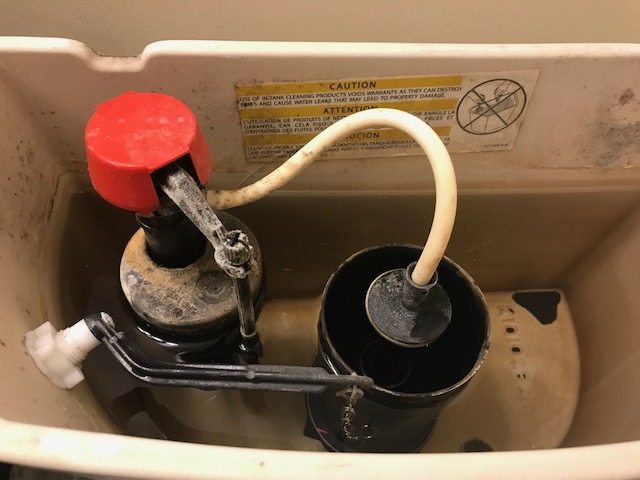If you’re buying a new toilet for a new (or old!) home, you should understand what the difference is between canister flush valves and flappers. Both devices allow your toilet to flush, but they each have their pros and cons.
If you want to know what it costs, how they flush, and what you’ll be paying upfront and for repairs, keep reading.
Canister Flush Valve
You’ll find a long, cylindrical valve assembly in modern toilets. The valve opens when you activate the flush, forcing water into the toilet bowl.
Canister valves are comprised of several moving parts that makes them a more complex feature of the modern toilet. They last for years before any significant wear is found in any of the components.
Pros
- Efficient
- High flushing power
- Durable
- Forces a lot of water through in one flush
Cons
- Maintenance is complicated
- Fixes are expensive
- Several moving parts
Flapper Valve
Flappers are an older type of flush valve consisting simply of a piece plastic or rubber connected to a chain that pulls it upwards when the flush activates, allowing water to cross into the bowl.
Pros
- Small number of moving parts
- Maintenance is easy
- Repairs are cheap
Cons
- Breaks more often
- Less water throughput
- Flushing is less efficient
Canister Flush Valve vs Flapper: How Do They Differ?
| Comparing factors | Canister Flush Valve | Flapper Valve |
| Moving parts | Several | Not many |
| Valve diameters | 3.5” or more | Rarely have diameters above 2” |
| Water use | A lot | Less |
| Flushing efficiency | More | Less |
| Flushing power | More powerful | Less powerful |
| Maintenance | Complicated | Easy |
| Repairs | Expensive | Cheap |
| Replacement | Doesn’t need frequent replacement | May need frequent replacement |
| Price | Costs anywhere between $20 and $26 | Cheaper, not more than $15 |
1. Valve Diameter
Flushing power is mostly determined by the diameter of the valve. Flapper valves will rarely have diameters above 2” while most canister valves are upwards of 3.5”, giving them more power.
2. Flushing Efficiency
There isn’t a significant difference in direct flushing efficiency between the two types of valves. However, it’s important to note that most canister valves offer dual flushing modes depending on how much water you need to use.
Taking this into consideration, your long-term water usage might be more efficient when using a canister valve.
3. Flushing Power
As mentioned above, the diameter of the valve is a big determinant of the flushing power. The water flows through what’s known as a trapway.
The larger the diameter of the valve, the larger trapway it can work with. So, bear in mind that a larger trapway will give your toilet a more powerful flush.
4. Repair and Replacement
Canister flush valves are more complex than a flapper. They have several moving parts compared to the flapper’s two or three and so are more complicated and expensive to replace.
However, canister valves are far more durable than a flapper. They can last for years without needing maintenance. Flappers on the other hand more often need the chain or the flapper itself to be replaced. Maintaining a flapper is very straightforward and cheap.
5. Cost
Canister flush valves are more expensive than flappers considering their size and additional moving parts. They cost generally cost anywhere between $20 and $26. While flappers are cheaper, at up to $14, you’ll have to replace them more often.
Which One Should You Choose?
Which valve you choose mostly depends on your budget. Flappers are cheap and easy to repair, but you’ll be paying to replace them more often and you won’t get the same flush power as you would from a canister flush valve.
Canister flush valves have the power and efficiency. They’re more expensive and the repairs will cost you too, but you should nominally be repairing them once every five to six years.
So, which should you go for? If you’re on a tight budget, the flapper is a good choice. If you can afford to spend a little more for the flushing power, go for the canister flush valve that has the added benefit of costing less in the long term.
FAQs
1. How do I know if the valve needs repairing?
Ans. There are certain signs of a broken valve you should keep an eye out for:
- The power drops suddenly when you flush
- The tank is taking longer than usual to fill
- You can hear water constantly running in the tank even after it should have filled. Test for leaks by dropping some food coloring into the tank and see if it flows out into the bowl.
If you notice any of these things, check out your flush valve and see what needs repairing.
2. How long should my flush valve last?
Ans. You can expect most valves to last for up to six to seven years, with some repairs in between. Like most things, valves will last longer depending on how often they’re used.
3. Can I upgrade from a flapper to a canister flush valve?
Ans. Toilets are designed based on the flush valve they use. Older toilets are built for flappers, more modern toilets are built for canister flush valves. They won’t support changes to the type of flush valve so no, you won’t be able to upgrade.








Leave a Comment